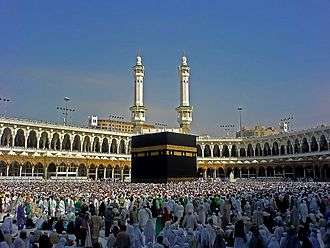Salah
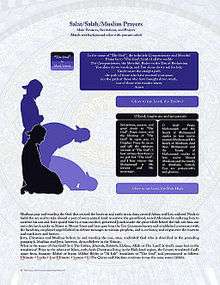
| Part of a series on |
| Islam |
|---|
 |
|
Aqidah |
|---|
 |
|
Including: 1Alawites & Qizilbash 2Sevener-Qarmatians, Assassins & Druzes 3Ajardi, Azariqa, Bayhasiyya, Najdat & Sūfrī 4Nūkkārī; 5Bahshamiyya & Ikhshîdiyya 6Alevism, Bektashi Order & Qalandariyya |
Salah ("worship", صلاة; pl. صلوات ṣalawāt; also salat), or namāz (Persian: نَماز) in some languages, is one of the Five Pillars in the faith of Islam and an obligatory religious duty for every Muslim (Male & Female, with certain exemptions based on Taqwa). It is a physical, mental, and spiritual act of worship that is observed five times every day at prescribed times. When they do this, they must face Mecca. In this ritual, the worshiper starts standing, bows, prostrates themself, and concludes while sitting on the ground.[1] During each posture, the worshiper recites or reads certain verses, phrases and prayers. The word salah is commonly translated as "prayer" but this definition might be confusing. Muslims use the words "dua" or "supplication" when referring to the common definition of prayers which is "reverent petitions made to God".
Salah is preceded by ritual ablution. Salah consists of the repetition of a unit called a rakʿah (pl. rakaʿāt) consisting of prescribed actions and words. The number of obligatory (fard) rakaʿāt varies from two to four according to the time of day or other circumstances (such as Friday congregational worship, which has two rakats). Prayer is obligatory for all Muslims except those who are prepubescent, are menstruating, or are experiencing bleeding in the 40 days after childbirth.[2] Every movement in the salah is accompanied by the takbir except the standing between the ruku and sujud, and the ending which has a derivation of the Muslim greeting As-salamu alaykum.[3]
Terminology
Salah (ṣalāh [sˤɑˈlɑː] صلاه) is an Arabic word whose basic meaning is "communication". In its English usage, the reference of the word is almost always confined to the Muslim formal, obligatory described in this article.
Translating salah as "communication" is not usually considered precise enough, as "communication" can indicate several different ways of relating to God; personal communication or supplication is called duʿāʾ (Arabic: دُعَاء, literally "invocation") in Islamic usage.
Muslims themselves use several terms to refer to salah depending on their language or culture. In many parts of the world, including many non-Arab countries, the Arabic term salat or salah is used. The other major term is the Persian word namāz (نماز), used by speakers of the Indo-Iranian languages (e.g., Farsi, the Kurdish languages, Urdu, Pashto, Balochi, Hindi), as well as Turkish, Russian, Chinese, Bosnian and Albanian. In North Caucasian languages, the term is lamaz (ламаз) in Chechen, chak (чак) in Lak and kak in Avar (как). In Indonesia, the term salat is officially used, as well as a local term sembahyang (means: communication, literally from the word sembah - worship and hyang - god or deity) is used too.
Salah in the Quran
الم ذَٰلِكَ ٱلْكِتَٰبُ لَا رَيْبَۛ فِيهِۛ هُدًى لِّلْمُتَّقِينَٱلَّذِينَ يُؤْمِنُونَ بِٱلْغَيْبِ وَيُقِيمُونَ ٱلصَّلَوٰةَ وَمِمَّا رَزَقْنَٰهُمْ يُنفِقُونَ وَٱلَّذِينَ يُؤْمِنُونَ بِمَآ أُنزِلَ إِلَيْكَ وَمَآ أُنزِلَ مِن قَبْلِكَ وَبِٱلآخِرَةِ هُمْ يُوقِنُونَ أُو۟لَٰٓئِكَ عَلَىٰ هُدًى مِّن رَّبِّهِمْۖ وَأُو۟لَٰٓئِكَ هُمُ ٱلْمُفْلِحُونَ
— Qur'an 2:2-5
Translation:
2. This is the Book about which there is no doubt, a guidance for those conscious of Allah -
3. Who believe in the unseen, establish prayer, and spend out of what We have provided for them,
4. And who believe in what has been revealed to you, and what was revealed before you, and of the Hereafter they are certain.
5. Those are upon guidance from their Lord, and those are the successful.
وَأَقِيمُوا۟ ٱلصَّلَوٰةَ وَءَاتُوا۟ ٱلزَّڪَوٰةَ وَٱرْڪَعُوا۟ مَعَ ٱلرَّٰڪِعِينَ
— Qur'an 2:43
Translation: And establish prayer and give Zakah and bow with those who bow [in worship and obedience].
- Guard your communication and middle communication; and stand before God devoutly obedient. Then if you fear on foot or riding; then when you become secure remember God as he has taught you that which you did not know previously. (Al-Quran 2:238-239)
- And offer communication at the two ends of day and at the approach of night; indeed good deeds remove bad deeds; this is a reminder for those who remember. (Al-Quran 11:114)
- offer communication at the decline of the day until the darkness of night; and Quran at dawn; indeed Quran at dawn ever is a witness. And at night pray Tahajjud an extra for thee; it is expected that your lord raise you to praised station. (Al-Quran 17:78-79)
- Say call God or call Merciful ; by whomever you call; He has good names; and do not make your Salah loud nor make silent and choose a path between them. (Al-Quran 17:110)
- And offer communication and pay Zakah and obey Messenger so that you may receive mercy.(Al-Quran 24:56)
- And recite that is revealed to you as a book and offer communication; indeed communication prohibits immorality and wrongdoing; and remembrance of God is great; and God is aware of what you do. (Al-Quran 29:45)
Purpose and importance
.jpg)
The chief purpose of salah is to act as a person's communication with and remembrance of God. By reciting "The Opening", the first sura (chapter) of the Quran, as required in daily worship, the worshiper can stand before God, thank and praise him, and ask for guidance along the "Straight Path".
In addition, daily worship reminds Muslims to give thanks for God's blessings and that submission to God takes precedence over all other concerns, thereby revolving their life around God and submitting to His will. Worship also serves as a formal method of dhikr or remembering God.[4]
Muslims believe that all prophets of God offered daily prayers and were humble in submission to the oneness of God. Muslims also believe that the main duty of the prophets of God is to teach mankind to humbly submit themselves to oneness of God.[5]
In Quran, it is written that: "For, Believers are those who, when God is mentioned, feel a tremor in their hearts, and when they hear his signs rehearsed, find their faith strengthened, and put (all) their trust in their Lord;"[6]
"To those whose hearts, when God is mentioned, are filled with fear, who show patient perseverance over their afflictions, keep up regular prayer, and spend (in charity) out of what we have bestowed upon them."[7]
Salah is also cited as a means of restraining a believer from social wrongs and moral deviancy.[8]
According to a hadith in the collection Sahih Bukhari, Muhammad considered salah "the best deed".[9]
The importance of the Salah was further demonstrated by Muhammad who on his deathbed and in the pangs of death would announce: "The Salah, [I remind you of] the Salah; and [to treat well] those who are in your power."[10]
Conditions
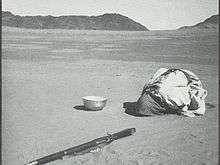
At the bottom of the central nave of the prayer hall there is a niche (the mihrab) indicating the qibla. This compulsory act of worship is obligatory for those who meet these conditions:[11]
- are Muslim
- are of sound mind
- have reached the age of puberty (beginning at age seven is recommended).[12]
Elements that make salah valid:[11]
- Confidence of the time of worship.[13]
- Facing the qibla, with the chest facing the direction of the Kaaba. The ill and the old are allowed leniency with posture.
- Covering the awrah[14]
- Clean clothes, body, place of prostration.
- Ritual purity (wudu, tayammum, ghusl)
- Praying in front of a sutrah is recommended.
The place of worship should be clean. In a few cases where blood is leaving the body, salah is forbidden until a later time. Women are not allowed to pray during their menses and for a period after childbirth.[15][16][17]
Preparation
Cleanliness and dress
Islam advises that salah be performed in a ritually clean environment.[18] When worshipping, the clothes that are worn and the place of prayer must be clean. Both men and women are required to cover their bodies (awrah) in reasonably loose-fitting garments. The well-known adage or hadith by al-Nawawi that "purity is half the faith"[19] illustrates how Islam has incorporated and modified existing rules of purity in its religious system.
Ritual ablution
Before conducting salah, a Muslim has to perform a ritual ablution. The minor ablution is performed using water (wudu), or sand (tayammum) when water is unavailable or not advisable to use for reasons such as illness. Wudu is performed by Muslims according to the instructions of God given in the Quran:
"O you who believe! when you rise up to prayer, wash your faces and your hands as far as the elbows, and wipe your heads and your feet to the ankles; and if you are under an obligation to perform a total ablution, then wash (yourselves) and if you are sick or on a journey, or one of you come from the privy, or you have touched the women, and you cannot find water, betake yourselves to pure earth and wipe your faces and your hands therewith, Allah does not desire to put on you any difficulty, but He wishes to purify you and that He may complete His favor on you, so that you may be grateful."
More specifically, wudu is performed by Muslims by washing the hands, mouth, nose, arms, face, hair (often washing the hair is merely drawing the already wet hands from the fringe to the nape of the neck), ears, and feet three times each in that order. (It is not obligatory to wash the hair three times, once is sufficient, and men must also wash their beard and mustache when washing the face).
Call to prayer
"Adhan" is the Islamic call to prayer, recited by the one known as the muezzin for the five obligatory prayers, traditionally from a tower called a minaret. A second call immediately before praying, known as the Iqama, is for the assembled Muslims in the prayer area to line up for the beginning of the prayers.
Intention
The person should be conscious and aware of the particular salah that is being offered, whether it is obligatory, if it is a missed (qadha) worship, performed individually or among the congregation, a shortened traveller's worship etc. The explicit verbalization of this intention is not required. The person should think his worship to be the Last Worship so that he may perform the best he can.
Components
Each salah is made up of repeating units or cycles called rakats. The number of rakats for the five daily worships can be found below.
People who find it physically difficult can perform Salah in a way suitable for them.[note 1] A basic rakat is made up of these parts.
Standing

- If this is the first rakah then prayer is commenced by the saying of the takbīr, which is اَللهُ أَكْبَرْ (transliteration "allāhu 'akbar", meaning "Allah is greatest"). The hands are raised up to the shoulders with palms facing the front i.e. Qibla. This is done before, with or after saying the takbir. Both arms are placed on either the chest or above the navel.[20]
- If this is the first rakat, a supplication praising Allah is said such as
سُبْحَاْنَكَ اَلْلّٰھُمَّ وَبِحَمدِكَ وَتَبَارَكَ اسْمُكَ وَتَعَالٰی جَدُّكَ وَلَا اِلٰى غَیْرِكَ
meaning [Glorified be you, all praise is yours, perfect is your name, most high is your majesty and greatness. None has the right to be worshipped but you, the only one God.]
Subḥānaka llāhumma, wa-bi-ḥamdika, wa-tabāraka smuka, wa-taʿālā jadduka, wa-lā ʾlāha ġayruk.[20]
- The recitation of the Quran begins by asking refuge with God from the accursed devil by reciting
أَعُوْذُ بِاللهِ مِنَ الشَّـيْطٰنِ الرَّجِيْمِ
aʿūḏu bi-llāhi mina š-šayṭāni r-rajīm.[20]
- Surah Al-Fatiha is recited.
- For the first or second rakat only, the recitation of Al-Fatiha is followed with a recitation from any other surah from the Quran of choice.[20] The customary practice is reciting the ayahs in order found in the Qur'an.
- The takbīr is said again and the hands are raised as previously described and the next position, bowing or ruku', begins.[20]
Bowing ( Ruku' )
- The palms are placed on the knees. Ideally, fingers are spaced out.
- Some of many types of remembrances of God are recited for this situation such as سبحان ربي العظيم (transliteration subḥāna rabbī l-ʿaẓīm, meaning "Glorified be Allah, the greatest") three times or more.[20]
Second standing
- I'tidal is the standing again after ruku'. The back is straightened and the hands are raised as in takbir as mentioned before (not raised in Hanafi and Maliki schools) while saying سمع الله لمن حمده (transliteration samiʿa allāhu li-man ḥamidahu, meaning "God listens and responds to the one who praises him.")[20]
- Some of many praises to God are said for this situation such as ربنا لك الحمد (transliteration rabbanā laka al-ḥamd, meaning "O Lord, all praise is for you.")[20]
- The takbīr is said and the hands can be raised as mentioned before as the next position (not raised in Hanafi and Maliki schools).[20]
Prostration
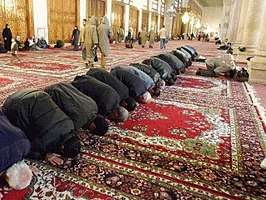
Each cycle of prayer contains 2 prostrations.[20] During the prostration:
- The nose and the forehead are placed on the ground along with the knees, palms and toes.[20]
- Some of many types of remembrances of God are recited for this situation such as سبحان ربى الأعلى وبحمده (transliteration subḥāna rabbī al-'aʿlā wa-bi-ḥamdihi meaning "Glorified be my God, the highest.") three times or more.[20]
- The takbīr is said again and the hands can be raised as mentioned before (not raised in Hanafi and Maliki schools) while the next position, kneeling, begins.[20]
Sitting

- The person performing the prayer sits between the two prostrations.
Second prostration
- Second prostrations are done exactly as the first time.
- The head is raised and the takbir is said again and the hands can be raised as mentioned before (not raised in Hanafi and Maliki schools). For every second and last rakat only you would go to the sitting position again. Otherwise, the standing position begins again for the start of a new rakat.
Second sitting
- If this is the second raka'ah, sitting is done as before. If this is not part of the second raka'ah, then the left thigh is leans against the ground and both feet are protruding from the right side with the right foot either upright or along the ground. The left palm leans on the left knee.
- The right index finger is pointed towards the qibla.[20]
- The Tashahhud is recited.
- Greetings on Muhammad, called the aṣ-ṣalātu ʿalā n-nabī are recited.
- If this is not the last raka'ah, a new raka'ah begins by standing up again with the takbir and the hands can be raised as mentioned before.[20]
- If this is the last raka'ah, the greetings of taslim are said to the right such as السلام عليكم ورحمة الله (transliteration "as-salāmu ʿalaykum wa raḥmatu llāh," meaning "Peace and God's mercy be upon you") and then similarly to the left.[20]
Performing the Taslim Reciting the salam facing the right direction Reciting the salam facing the left direction
Differences in practice

The Islamic worship practiced by one Muslim may differ from another's in minor details, which can affect the precise actions and words involved. Differences arise because of different interpretations of the Islamic legal sources by the different schools of law (madhhabs) in Sunni Islam, and by different legal traditions within Shia Islam. In the case of ritual worship these differences are generally minor, and should rarely cause dispute.[21] Muslims believe that Muhammad practiced, taught, and disseminated the worship ritual in the whole community of Muslims and made it part of their life. The practice has, therefore, been concurrently and perpetually practiced by the community in each of the generations. The authority for the basic forms of the Salah is neither the hadiths nor the Qur'an, but rather the consensus of Muslims.[22] Differences also occur due to optional (recommended rather than obligatory) articles of prayer procedure, for example, which verses of the Quran to recite. A 2015 Pew Research Center study found that women are two percent more likely than men to pray on a daily basis.[23]
Shia Muslims, after the end of the prayer, raise their hands three times, reciting Allah hu akbar and Sunnis just look at the left and right shoulder saying salams. Also Shias in the second Rakat often read "Qunoot", which for Sunnis is often done after salah.
In each of the positions, the Muslim usually needs to consider these, which may vary between schools and gender:
- Position of legs and feet.
- Position of hands, including fingers
- Place where eyes should focus
- The minimum amount of adhkar/recitation, depending upon whether the worshipper is Imam or following the Imam or praying alone.
- Loudness of recitation: audible, or moving of lips, or just listening
Steps that are compulsory or necessary in the 5 daily prayers[24][25][26][27][28][29]
Ahmadi Muslims have the same Salah practices as those belonging to the Hanafi madhab.
Types of prayers
Prayers in Islam are classified into four categories based on degrees of obligation: fard, wajib, sunnah, and nafl.[30]
The Five Daily Prayers
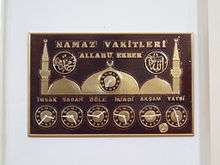
Muslims are commanded to perform prayers five times a day.[31] These prayers are obligatory on every Muslim who has reached the age of puberty, with the exception being those who are mentally ill, too physically ill for it to be possible, menstruating, or experiencing postnatal bleeding. Those who are ill or otherwise physically unable to offer their prayers in the traditional form are permitted to offer their prayers while sitting or lying, as they are able. The five prayers are each assigned to certain prescribed times (al waqt) at which they must be performed, unless there is a compelling reason for not being able to perform them on time. These times are measured according to the movement of the sun. These are: near dawn (fajr), after midday has passed and the sun starts to tilt downwards/noon (zuhr), in the afternoon (asr), just after sunset (maghrib) and around nightfall (Isha). Under some circumstances ritual worship can be shortened or combined (according to prescribed procedures). In case a ritual worship is not performed at the right time, it must be performed later.
Some Muslims offer voluntary prayers (sunna rawatib) immediately before and after the prescribed fard prayers. Sunni Muslims classify these prayers as sunnah, while Shi'ah consider them nafil. The number of rakats for each of the five obligatory prayers as well as the voluntary prayers (before and after) are listed below:
| Name | Prescribed time period (waqt) | Voluntary before fard[t 1] | Obligatory | Voluntary after fard[t 1] | ||
|---|---|---|---|---|---|---|
| Sunni | Shi'a | Sunni | Shi'a | |||
| Fajr (فجر) |
Dawn to sunrise, should be read at least 10–15 minutes before sunrise | 2 Rakats Sunnat-Mu'akkadah[t 1] | 2 Rakats[t 1] | 2 Rakats[t 1] | — | 2 Rakats[t 1] |
| Zuhr (ظهر) |
After true noon until Asr | 4 Rakats Sunnat-Mu'akkadah[t 2] | 4 Rakats | 4 Rakats[t 3] | 2 Rakats Sunnat-Mu'akkadah[t 2] | 8 Rakats[t 1][t 4][t 5] |
| Asr (عصر) |
Afternoon[t 6][t 7] | 4 Rakats Sunnat-Ghair-Mu'akkdah | 4 Rakats | 4 Rakats | - | 8 Rakats[t 1][t 4][t 5] |
| Maghrib (مغرب) |
After sunset until dusk | - | 3 Rakats | 3 Rakats | 2 Rakats Sunnat-Mu'akkadah[t 2] | 2 Rakats[t 1][t 4][t 5] |
| Isha (عشاء)[t 8] | Dusk until dawn[t 7] | 4 Rakats Sunnat-Ghair-Mu'akkadah | 4 Rakats | 4 Rakats | 2 Rakats Sunnat-Mu'akkadah,[t 2] 3 Rakats Witr |
2 Rakats[t 1][t 4][t 5] |
Sunni Muslims also perform two rakats nafl (voluntary) after the Zuhr and Maghrib prayers. During the Isha prayer, they perform the two rakats nafl after the two Sunnat-Mu'akkadah and after the witr prayer.
Table notes
- 1 2 3 4 5 6 7 8 9 10 According to Shia Muslims, these are to be performed in sets of two rakats each. This is not the case for Sunni Muslims.
- 1 2 3 4 According to Sunni Muslims, there is a difference between Sunnat-Mu'akkadah (obligatory) and Sunnat-Ghair-Mu'akkadah (voluntary). Unlike for the Sunnat-Ghair-Mu'akkadah, the Sunnat-Mu'akkadah was prayed by Muhammed daily.
- ↑ Replaced by Jumu'ah on Fridays, which consists of two rakats.
- 1 2 3 4 Mustahab (praiseworthy) to do everyday. (Shias)
- 1 2 3 4 According to Shia Muslims, this prayer is termed nawafil.
- ↑ According to Imam Abu Hanifa, "Asr starts when the shadow of an object becomes twice its height (plus the length of its shadow at the start time of Zuhr)." For the rest of Imams, "Asr starts when the shadow of an object becomes equal to its length (plus the length of its shadow at the start time of Zuhr)." Asr ends as the sun begins to set.
- 1 2 According to Shia Muslims, Asr prayer and Isha prayer have no set times but are performed from mid-day. Zuhr and Asr prayers must be performed before sunset, and the time for Asr prayer starts after Zuhr has been performed. Maghrib and Isha prayers must be performed before midnight, and the time for Isha prayer can start after Maghrib has been performed, as long as no more light remains in the western sky signifying the arrival of the true night.
- ↑ Further information on the usage of the word "Isha" (evening) see Quran 12:16, Quran 79:46
Fard Salah

The Fard Salah are all of the compulsory Muslim prayers - the five daily prayers, as well as the Friday prayer (Salat al-Jumu'ah) and the Eid prayers (Eid prayers). Non-performance of any these prayers renders one a non-Muslim according to the stricter Hanbali madhhab of Sunni Islam, while the other Sunni madhhabs simply consider doing so a major sin. However, all four madhhabs agree by consensus that denial of the compulsory status of these prayers invalidates the faith of those who do so, rendering them non-Muslim. Fard prayers (as with all fard actions) are further classed as fard al-ayn (obligation of the self) and fard al-kifayah (obligation of sufficiency). Fard al-Ayn are actions considered obligatory on individuals, for which the individual will be held to account if the actions are neglected. Fard al-Kifayah are actions considered obligatory on the Muslim community at large, so that if some people within the community carry it out no Muslim is considered blameworthy, but if no one carries it out, all incur a collective punishment.
Men are required to perform the fard salat in congregation (jama'ah), behind an imam when they are able. According to most Islamic scholars, performing prayers in congregation is mustahabb (recommended) for men,[32] when they are able, but is neither required nor forbidden for women.
Jumu'ah
Salat al-Jumu'ah is a congregational prayer on Friday, which replaces the Zuhr prayer. It is compulsory upon men to perform it in congregation, while women may perform it so or may perform Zuhr salat instead. Salat al-Jumu'ah consists of a sermon (khutba) given by the speaker (khatib) after which two rakats are performed. There is no Salat al-Jumu'ah without a khutba. Khutba supposed to be carefully listened as it replaces Sawaab of 2 Rakats.
| Name | Prescribed time period (waqt) | Voluntary before fard | Obligatory | Voluntary after fard | ||
|---|---|---|---|---|---|---|
| Sunni | Shi'a | Sunni | Shi'a | |||
| Jumu'ah (جمعة) |
After true noon until Asr | 4 Rakats Sunnat-e-Mu'akkadah | 2 Rakats Sunnat/ Mustahab | 2 Rakats | 2 Rakats Sunnat Mu'akkadah
2 Rakats Nafil |
|
Wajib salat
Wajib As-salat are compulsory, non-performance of which renders one a sinner. However, the evidence of the obligation is open to interpretation, with some of the madhab saying it is obligatory while others saying it is optional. To deny that a fard salah is obligatory is an act of disbelief while denying the obligation of a wajib salat is not disbelief. There are some who believe that as the 5 prayers are obligatory, it automatically renders all other prayers optional.
Sunnah salah

Sun'nah sal'ah are optional and were additional voluntary prayers performed by Muhammad—they are of two types—the Sunnah Mu'akkaddah, those practiced on a regular basis, which if abandoned cause the abandoner to be regarded as sinful by the Hanafi School and the Sunnah Ghair Mu'akkaddah, those practiced on a semi-regular practice by Muhammad about which all are agreed that their abandonment doesn't render one sinful.
Certain sunnah prayers have prescribed waqts associated with them. Those ordained for before each of the fard prayers must be performed between the first call to prayer (adhan) and the second call (iqama), which signifies the start of the fard prayer.[33] Those sunnah ordained for after the fard prayers can be performed any time between the end of the fard prayers and the end of the current prayer's waqt.[33] Any amount of extra rakats may be offered, but most madha'ib prescribe a certain number of rakats for each sunnah salah.
Nafl salah
Nafl salah (supererogatory prayers) are voluntary, and one may offer as many as he or she likes almost any time.[34] There are many specific conditions or situations when one may wish to offer nafl prayers. They cannot be offered at sunrise, true noon, or sunset.[35] The prohibition against salah at these times is to prevent the practice of sun worship.
Salat-al-Witr
Witr is performed after the salah of Isha (dusk). Some Muslims consider witr wajib while others consider it optional. It may contain any odd number of rakats from one to eleven according to the different schools of jurisprudence. However, Witr is most commonly offered with three rakats.
To end prayers for the night after Isha, the odd numbered rakats must have the niyyah of "wajib-ul-Lail", which is mandatory to "close" one's salah for that day.
Shi'ahs offer this as a one rakat salah at the end of salatul layl (the night prayer), which is an optional prayer according to some shi'ah scholars, and a wajib (obligatory) prayer according to others. This is to be prayed any time after Isha, up until fajr. The best time to pray it is the last third of the night (the night being divided into three, between maghrib and fajr of that night). It is considered highly meritorious by all shi'ah Muslims, and is said to bring numerous benefits to the believer, mainly gaining proximity to Allah. There are various methods of salatul-layl's performance, including shorter and longer versions, in the longer version the believer must perform 8 nawafil salah, in sets of 2 rakats each, then they must pray a 2 rakats salah called 'salatul shafa'ah' this is to include surah nas after surah fatihah in the first rakat and surah falaq after surah fatihah in the secound rakat, and unusually no qunut (a du'ah recited before going into ruku' of the second rakat of most prayers performed by shi'ahs) It is after this that the believer performs salatul witr, it's long method being - Starting with takbiratul ehram, then surah fatihah, then surah ikhlas, then surah falaq, then surah nas, then the hands are raised to recite qunut, upon which the believer can recite any du'a, however there are many recommended du'as for this purpose. Within qunut, the believer must pray for the forgiveness of 40 believers, then further prayers are read where the believer asks for forgiveness for himself a certain number of times using specified phrases and amounts of time to repeat those phrases. The believer then completes the salah in the usual way, by completing his qunut, reciting takbir whilst rasing his hands, going into ruku' and reciting the usual phrase for that, then returning up right and reciting takbir whilst doing so and upon being upright recites 'sami allahu liman hamida' (verily Allah has heard the one who has praised him) thereupon the believer recites takbir whilst raising his hands and goes into sajda. He recites the proscribed phrase in sajda rises, recites takbir whilst rising and then again whilst returnin to sajdah, then rises with takbir again and recites tashahud and salam, thus ending this prayer. It is then optional to recite certain other du'as and dhikr (remembrance of Allah through certain phrases and some of his names being repeated) It is then recommended to perform and sajdah ash-shukr (prostration of thanks) and to then recite ayatul kursi (verse of the throne) and then perform another sajdah ash-shukr.
Eid

Eid salah is performed on the morning of Eid al-Fitr and Eid al-Adha. The Eid prayer is most likely an individual obligation (fard al-ayn) and Niyyah for both Eid salah is made as Wajib, though some Islamic scholars argue it is only a collective of the obligation(fard al-kifayah).[36] It consists of two rakats, with seven (or three for the followers Imam Hanafi) takbirs offered before the start of the first rakat and five (or three for the followers of Imam Hanafi) before the second. After the salah is completed, a sermon (khutbah) is offered. However, the khutbah is not an integral part of the Eid salah.[37] The Eid salah must be offered between sunrise and true noon i.e. between the time periods for Fajr and Zuhr.
Istikhaarah
Salat al-Istikhaarah is a prayer performed when a Muslim needs guidance on a particular matter, such as whether they should marry a certain person. In order to perform this salah one should pray a normal two rakats salah to completion. After completion one should say a du'a called the Istikhaarah du'a. The intention for the salah should be in one's heart to pray two rakats of salah followed by Istikhaarah. The salah can be performed at any of the times where salah is not forbidden.
The salah must be performed in the Arabic language.
Qada
In certain circumstances one may be unable to perform one's prayer within the prescribed time period (waqt). In this case, the prayer must be performed as soon as one is able to do so. Several Ahadith narrate that Muhammad stated that permissible reasons to perform Qada Salah are forgetfulness and accidentally sleeping through the prescribed time. However, knowingly sleeping through the prescribed time for Salah is deemed impermissible.
Qasr and Jam' bayn as-Salaatayn
When travelling over long distances, one may shorten some prayers, a practice known as qasr. Furthermore, several prayer times may be joined, which is referred to as Jam' bayn as-Salaatayn. Qasr involves shortening the obligatory components of the Zuhr, Asr, and Isha prayers to two rakats. Jam' bayn as-Salaatayn combines the Zuhr and Asr prayers into one prayer offered between noon and sunset, and the Maghrib and Isha prayers into one between sunset and Fajr. Neither Qasr nor Jam' bayn as-Salaatayn can be applied to the Fajr prayer.
There is no reference to Qasr during travel within the Qur'an itself; the Qur'an allows for Qasr when there is fear of attack, but does not forbid it for travel in non-hostile circumstances.
Sajdah of forgetfulness
During the ritual salat prayer, if a person forgets to do one of the actions of prayer he can make up for certain actions by performing two sujud at the end of the prayer. This can only be done if specific types of actions are forgotten by the person praying.
Tahiyyatul masjid
Upon entering the mosque, "Tahiyyatul masjid" may be performed; this is to pay respects to the mosque. Every Muslim entering the mosque is encouraged to perform these two rakats.
Prayer in congregation
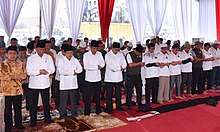
Prayer in congregation (jama'ah) is considered to have more social and spiritual benefit than praying by oneself. When praying in congregation, the people stand in straight parallel rows behind one person who conduct the prayer, called imam, and face the qibla. The imam is usually chosen to be a scholar or the one who has the best knowledge of the Qur'an, preferably someone who has memorised it (a hafiz). In the first row behind the imam, if available, would be another hafiz to correct the imam in case a mistake is made during the performance of the salah. The prayer is performed as normal, with the congregation following the actions and movements of the imam as he performs the salah.
Standing arrangement
For two people of the same gender, the imam would stand on the left and the other person is on the right. For more than two people, the imam stands one row ahead of the rest.
When the worshippers consist of men and women combined, a man is chosen as the imam. In this situation, women are typically forbidden from performing this role. This point, though unanimously agreed on by the major schools of Islam, is disputed by some groups, based partly on a hadith whose interpretation is controversial. When the congregation consists entirely of women and pre-pubescent children, one woman is chosen as imam. When men, women, and children are praying, the children's rows are usually between the men's and women's rows, with the men at the front and women at the back. Another configuration is where the men's and women's rows are side by side, separated by a curtain or other barrier, with the primary intention being for there to be no direct line of sight between male and female worshippers, following a Qur'anic injunction toward men and women each lowering their gazes (Qur'an 24:30–31).
Conducting
The prayer commences with the imam saying “Allahu akbar” out loud. For the five daily prayers, the imam would read the surah fatiha and a following section of the quran out loud only for the first two rakats of Fajr, Maghrib and Isha. To move between positions, the imam would say “Allahu akbar” out loud, such as when going to the bowing position, except when standing up again from the bowing position, when the imam would say “SamiAllahu liman hamidah” out loud. The prayer is concluded with the imam saying the taslim out loud.
A worshiper who has joined a congregation prayer late after missing rakats is called a masbuq. The masbuq would join with the rest of the group in prayer, however, when the taslim is said at the end, he or she would not say the taslim but would instead stand up and continue for the number of rakats missed. If he or she joined after the bowing stage of a rakat, then he or she would have considered to have missed that rakat.
Quranist Salah
The concept of Quranist Salah Timings has been discussed in Hujjat Allah Al-Baligha (Arabic/Urdu) by Shah Waliullah. He said that there are 3 Salah timings (prayers) instead of the 5 Salahs (prayers).[38]
The number of regular Salah mentioned by their respective names in Arabic in the Qur'an are three as follows:
- Ṣalāt Fajr (Dawn Prayer) [39]
- Aṣ-Ṣalāt al-Wusṭā ( The Middle Prayer) [40][41]
- Ṣalāt cIshā' (Night Prayer)[39][42]
The other Salah normally prayed by most Muslims are not explicitly mentioned in Qur'an by specific Arabic terms.[39] Most Muslims pray them by giving reference to the Hadith of Muhammad, and the consensus of Muslims, whereas Quranists may only pray the 3 times mentioned.
Salah timings according to Quranists
Salah timings of Qur'an are mentioned, in particular three salah times are described [42] and that they are recorded in a written document.[43] Also noted is the volume at which the salah should be uttered, somewhere in between spoken aloud and spoken in a low tone.[44]
The time for performing Fajr (Dawn) Prayer starts when the first thin ray of light is observed in the sky[45][46] and ends at the first "taraf" (terminal) of the day, or sunrise [42]
The time for performing middle or Salat Al-Wusta can be observed from the moment the sun begins its descend from its highest point in the sky (duluk al shams) until sunset but before the darkness of the night (ghasaq al-layl) starts to set in.[41]
'Duluk ash-shams' can also mean 'sunset.' It literally means 'the rubbing of the sun.' The most accepted meaning is that this means the apparent rubbing of the sun with the horizon at sunset. Although, the meaning of a declining noon sun can also be found in Classical Arabic sources. Literally, it can imply a meaning of both sunset and dawn in its meaning of a sun making apparent contact i.e. 'rubbing' with the horizon.
The Qur'an, if we take the understanding of 'a declining noon sun' implies that the time of the Middle prayer ends with sunset.[47]
Some Quranists however believe that there are only two Salah, dawn and dusk including the times of night close to these two periods; which is Based on the Qur'an (24:58). Some groups like Ahl Al-Quran and The Submitters believe that the 5 Salah as they are practiced by Muslims today were passed down from Abraham generationally through the Arabs and the Children of Israel, to then be inherited by those who adopted the Qur'an (and rejected by most Jews and Christians), as a ritual of the religion of Abraham.The emphasize on constantly mentioning of God in holy books, is believed to be about the believers' righteous endeavors and not just performing Salah. For instance, in (51:56) when God states: "I did not create the jinn and the humans except to worship Me;" worshiping God could not mean just performing the prayer ritual all day long.
See also
Notes
- ↑ For the able-bodied, leaning or not standing upright invalidates prayer. For those who are not able to, they can perform salat while sitting down (in case of illness or any situation like traveling in a vehicle, on a horse, etc), while lying down (in case of illness) and even with indication.
References
- ↑ "True Islam - Number of Salat". True Islam - Number of Salat. Retrieved 2016-02-20.
- ↑ Multicultural Handbook of Food, Nutrition and Dietetics, p. 43, Aruna Thaker, Arlene Barton, 2012
- ↑ al-Hassani, Abu Qanit (2009). The Guiding Helper: Main Text and Explanatory Notes. p. 123.
- ↑ "Archived copy". Archived from the original on 18 July 2011. Retrieved 4 October 2009.
- ↑ "Be Humble: It's a Sunnah". www.onislam.net. Retrieved 2015-09-28.
- ↑ Quran 8:2
- ↑ Quran 22:35
- ↑ Quran 29:45
- ↑ Sahih al-Bukhari, 4:52:41
- ↑ Narrated by At-Tabari. According to Al-Ghazali's Revival of Religious Sciences, "The last three directives which the Messenger of God repeated until his tongue began to stumble and his speech grew faint were: the salah, the salah, and those who are in your power, do not charge them to do more than they are capable of [...]." Original: وآخر ما وصى به رسول الله صلى الله عليه وسلم ثلاث كان يتكلم بهم حتى تلجلج لسانه وخفي كلامه: جعل يقول:" الصلاة الصلاة، وما ملكت أيمانكم لا تكلفوهم ما لا يطيقون. الله الله في النساء فإنهن عوان في أيديكم - يعني أسراء - أخذتموهن بأمانة الله واستحللتم فروجهن بكلمة الله إحياء علوم الدين
- 1 2 Ismail Kamus (1993). Hidup Bertaqwa (2nd ed.). Kuala Lumpur: At Tafkir Enterprise. ISBN 983-99902-0-9.
- ↑ Amatullah - Eritrea (3 May 2006). Group of Muftis, ed. "When Should Children Be Encouraged to Fast? - IslamonLine.net - Ask The Scholar". islamonline.net. Archived from the original on 18 August 2007. Retrieved 23 August 2009.
- ↑ "Rules of Salat (Part III of III)". Al-Islam.org.
- ↑ "Amr ʻAbd al-Munʻim Salīm, ''Important lessons for Muslim women'', Darussalam, 2005, page 174". Books.google.com. Retrieved 2018-01-08.
- ↑ Sahih Bukhari 1.6.301
- ↑ See also [Quran 2:282]: "... and call in to witness from among your men two witnesses; but if there are not two men, then one man and two women from among those whom you choose to be witnesses, so that if one of the two errs, the second of the two may remind the other...."
- ↑ "Women In Islam Versus Women In The Judaeo-Christian Tradition". twf.org.
- 1 2 Quran 5:6
- ↑ An-Nawawi's Forty Hadiths Archived 15 October 2008 at the Wayback Machine.
- 1 2 3 4 5 6 7 8 9 10 11 12 13 14 15 16 Haddad, Yvonne Yazbeck; Smith, Jane I. (2014-01-01). The Oxford Handbook of American Islam. Oxford University Press. p. 162. ISBN 9780199862634.
- ↑ Abdal Hakim Murad. "Understanding the Four Madhhabs". Retrieved 25 May 2010.
- ↑ Al-Mawrid Archived 24 July 2011 at the Wayback Machine.
- ↑ Swanson, Ana (2016-03-30). "Why women are more religious than men". The Washington Post. Retrieved 2018-01-08.
- ↑ "Share Islam" (PDF). islamtomorrow.com.
- ↑ "Page Title". haqqaninaqshbandiuk.com.
- ↑ "eShaykh: Salat Guide for Shafi'i". Google Docs.
- ↑ "Salat According to Shafii Fiqh". sunnah.org.
- ↑ "SALAH ACCORDING TO THE HANBALI SCHOOL OF THOUGHT". daruliftabirmingham.co.uk.
- ↑ "Imam Ali Foundation - London". najaf.org.
- ↑ "Understanding Salat" from Albalagh
- ↑ Muslim, Prayer Times NYC. "5 Prayers in Islam". Prayer Times NYC. PBC Times. Retrieved 26 July 2017.
- ↑ "Rules of Salat (Part III of III)". Al-Islam.org.
- 1 2 "Virtue and times of regular Sunnah prayers (Sunnah mu'akkadah) - islamqa.info". islamqa.info.
- ↑ "prayers". islamicsupremecouncil.com.
- ↑ "Namaz". World News.
- ↑ "Ruling on Eid prayers". Islam Question and Answer. Retrieved 2 January 2007.
- ↑ "Islam Today". Islam today. Archived from the original on 17 October 2007.
- ↑ "Hujjat Allah Al-Baligha (Arabic / Urdu) by Shah Waliullah / Shah Wali Ullah". scribd.com.
- 1 2 3 Quran 24:58
- ↑ Quran 2:238
- 1 2 Quran 17:78
- 1 2 3 Quran 11:114
- ↑ Quran 4:103
- ↑ Quran 17:110
- ↑ Quran 2:187
- ↑ Quran 52:49
- ↑ Quran 38:32
Further reading
- A Guide to Salat (Prayer) in Islam
- Smith, Jane I.; Haddad, Yvonne Yazbeck (1993). The Oxford Handbook of American Islam (1st ed.). Oxford: Oxford University Press. pp. 162–163.
External links
| Wikimedia Commons has media related to Salat. |
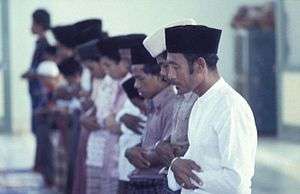
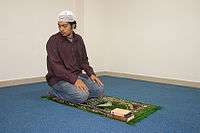
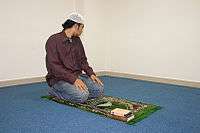
.jpg)
